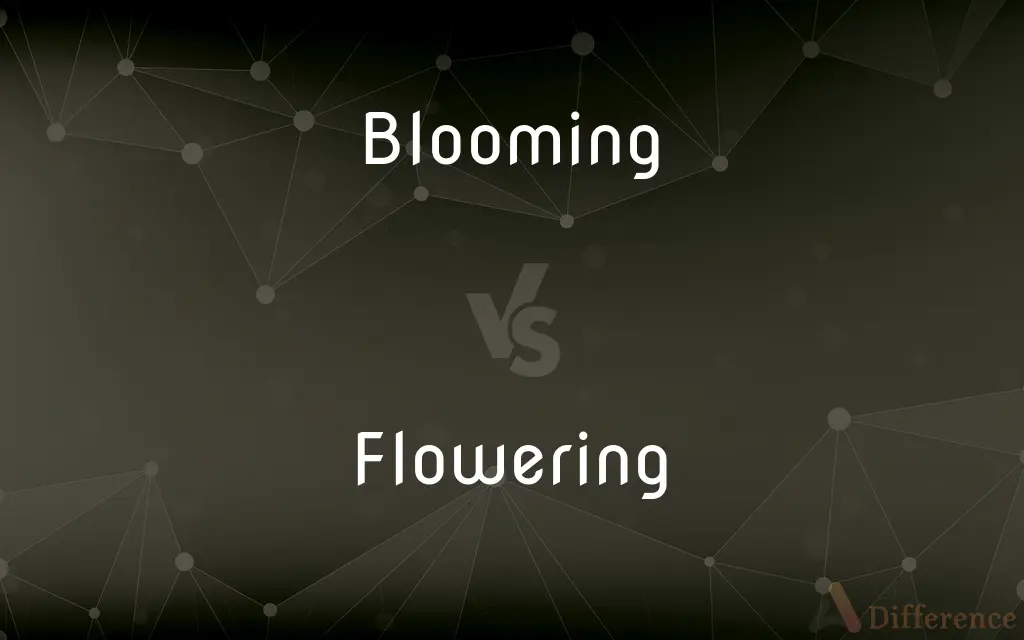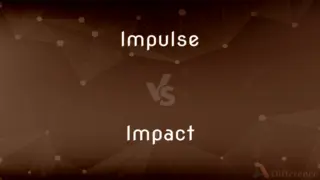Blooming vs. Flowering — What's the Difference?
Edited by Tayyaba Rehman — By Fiza Rafique — Updated on March 13, 2024
Blooming refers to the process of a flower opening, while flowering pertains to the phase when a plant produces flowers.

Difference Between Blooming and Flowering
Table of Contents
ADVERTISEMENT
Key Differences
Blooming specifically describes the moment or period when a flower unfolds its petals and becomes visible in its most attractive form. This term is often used to emphasize the beauty and transient nature of flowers at their peak. Flowering, on the other hand, refers to the broader stage in a plant's life cycle when it develops and presents flowers. This process includes the budding, blooming, and sometimes the withering of flowers.
While blooming focuses on the aesthetic and symbolic emergence of individual flowers, flowering encompasses the entire process by which plants produce flowers, from the initial bud formation to the end of the flower's life. Thus, flowering can be seen as a biological process critical for plant reproduction, involving not just the visual appeal of blooming but also the development of structures for pollination and seed production.
Blooming is a term often used in a more poetic or metaphorical sense, highlighting the beauty and ephemeral nature of flowers at their most visually striking stage. Flowering, however, is a more scientific term, denoting a phase in the plant's life cycle with important implications for the survival of the species, through mechanisms such as pollination and seed dispersal.
In gardening and horticulture, blooming is a key indicator of a plant's health and the success of its cultivation, signifying that the plant has met its necessary conditions for growth and reproduction. Flowering, while also a sign of health, is monitored for its duration and timing, as it affects not only the aesthetic appeal of gardens and landscapes but also agricultural and ecological outcomes, including crop yields and the maintenance of biodiversity.
Despite their differences, both blooming and flowering are integral to the appreciation and study of plants. Blooming brings joy and beauty to observers, symbolizing renewal and growth, whereas flowering plays a crucial role in ecosystems, supporting biodiversity through the relationships between plants and pollinators.
ADVERTISEMENT
Comparison Chart
Definition
The process of a flower opening its petals.
The phase of a plant producing flowers.
Focus
On the aesthetic appeal and emergence of individual flowers.
On the biological process of flower production.
Significance
Symbolic of beauty and renewal.
Important for plant reproduction and biodiversity.
Usage
Often used poetically or metaphorically.
Used in a scientific context regarding plant life cycles.
Implications
Indicates plant health and cultivation success.
Affects ecological outcomes and plant-pollinator relationships.
Compare with Definitions
Blooming
The opening of a flower's petals.
The garden was full of blooming roses.
Flowering
Essential for reproduction.
Flowering plants rely on bees for pollination.
Blooming
Indicates a specific moment.
The cactus was blooming under the moonlight.
Flowering
Monitored in agriculture.
Flowering times are crucial for crop management.
Blooming
Symbolizes beauty and growth.
The blooming cherry blossoms signal spring's arrival.
Flowering
A plant's phase of producing flowers.
The flowering season for lavender attracts many visitors.
Blooming
Reflects cultivation success.
The diligent care resulted in all the plants blooming.
Flowering
Can include various stages.
The plant's flowering process lasts several weeks.
Blooming
Aesthetically focused.
The blooming of the lotus is celebrated for its beauty.
Flowering
Supports biodiversity.
Flowering meadows are vital habitats for insects.
Blooming
Used as an intensive
A blooming hot day.
A blooming idiot.
Flowering
The reproductive structure of angiosperms, characteristically having either specialized male or female organs or both male and female organs, such as stamens and a pistil, enclosed in an outer envelope of petals and sepals.
Blooming
Present participle of bloom
Flowering
Such a structure having showy or colorful parts; a blossom.
Blooming
Opening in blossoms; flowering.
Flowering
A flower head.
Blooming
Thriving in health, beauty, and vigor, vigour; indicating the freshness and beauties of youth or health.
Flowering
A plant that is cultivated or appreciated for its blossoms.
Blooming
The act by which something blooms.
Flowering
The condition or a time of having developed flowers
The azaleas were in full flower.
Blooming
(metallurgy) The process of making blooms from the ore or from cast iron.
Flowering
The period of highest development or greatest vigor. ]
Blooming
(photography) A phenomenon where excessive light causes bright patches in a picture.
Flowering
(horticulture) The period of time during which a plant is in flower.
Blooming
The process of making blooms from the ore or from cast iron.
Flowering
(figurative) The period of time during which someone or something is at its peak.
Blooming
Opening in blossoms; flowering.
Flowering
(used only before the noun) Of a plant, that produces flowers.
Azaleas are flowering plants.
Blooming
Thriving in health, beauty, and vigor; indicating the freshness and beauties of youth or health.
Flowering
Aflower, in bloom
Blooming
The organic process of bearing flowers;
You will stop all bloom if you let the flowers go to seed
Flowering
Having conspicuous flowers; - used as an epithet with many names of plants; as, flowering ash; flowering dogwood; flowering almond, etc.
Flowering
The act of blossoming, or the season when plants blossom; florification.
Flowering
The act of adorning with flowers.
Flowering
The time and process of budding and unfolding of blossoms
Flowering
A developmental process;
The flowering of ante-bellum culture
Flowering
Bursting into flower;
Flowering spring trees
Common Curiosities
How do gardeners encourage blooming?
Gardeners encourage blooming through proper sunlight, watering, and nutrient management.
What's the main difference between blooming and flowering?
Blooming refers to the specific act of a flower opening, while flowering denotes the entire process of a plant producing flowers.
Is blooming important for pollination?
Blooming is crucial for pollination, as it exposes the reproductive parts of the flower to pollinators.
How does weather affect flowering and blooming?
Weather significantly affects both, with temperature, sunlight, and rain influencing the timing and success of flowering and blooming.
What role do blooming plants play in ecosystems?
Blooming plants provide food and habitat for pollinators, playing a critical role in ecosystems.
How do flowering times impact agriculture?
Flowering times impact agriculture by affecting crop yields and harvest times, requiring careful management.
Can blooming occur in plants that don't produce flowers?
No, blooming specifically refers to the opening of flowers, so plants without flowers do not bloom.
Can a plant be flowering without blooming?
Yes, a plant in the flowering stage may have buds that have not yet opened, meaning it's flowering but not all flowers are blooming.
Why is the flowering stage significant for plants?
The flowering stage is significant for plants because it leads to pollination and seed production, essential for species survival.
Can artificial light affect flowering and blooming?
Yes, artificial light can influence the flowering and blooming process, especially in plants sensitive to light cycles.
Do all flowering plants bloom at the same time?
No, flowering plants have varied blooming times based on species, climate, and environmental conditions.
What is meant by a plant's 'blooming period'?
A plant's blooming period refers to the time frame in which its flowers are open and visible.
How can I tell if a plant is in the flowering stage?
A plant in the flowering stage will develop buds, which are precursors to flowers.
What happens after a flower blooms?
After a flower blooms, it may be pollinated, leading to seed formation and eventually, the wilting of the flower.
Is blooming the same as flowering in all plants?
While related, blooming and flowering are not the same; blooming is a part of the flowering process, specifically the opening of the flower.
Share Your Discovery

Previous Comparison
Impulse vs. Impact
Next Comparison
Accomplish vs. SucceedAuthor Spotlight
Written by
Fiza RafiqueFiza Rafique is a skilled content writer at AskDifference.com, where she meticulously refines and enhances written pieces. Drawing from her vast editorial expertise, Fiza ensures clarity, accuracy, and precision in every article. Passionate about language, she continually seeks to elevate the quality of content for readers worldwide.
Edited by
Tayyaba RehmanTayyaba Rehman is a distinguished writer, currently serving as a primary contributor to askdifference.com. As a researcher in semantics and etymology, Tayyaba's passion for the complexity of languages and their distinctions has found a perfect home on the platform. Tayyaba delves into the intricacies of language, distinguishing between commonly confused words and phrases, thereby providing clarity for readers worldwide.















































